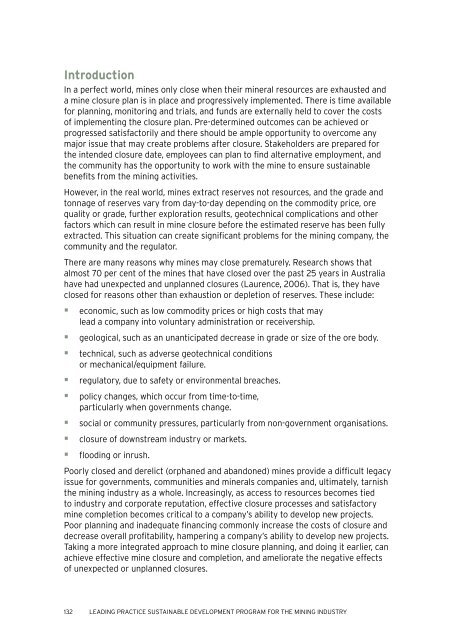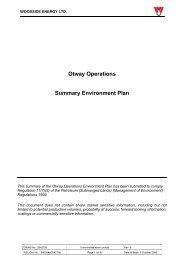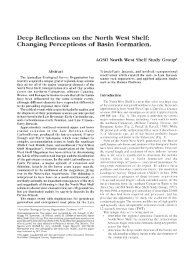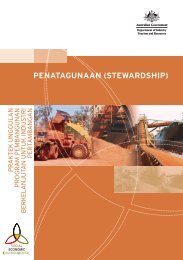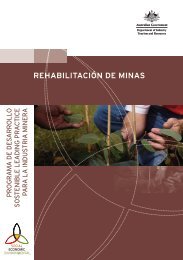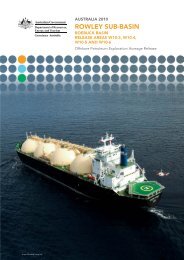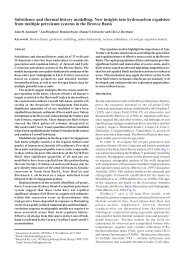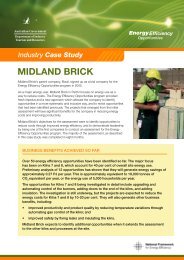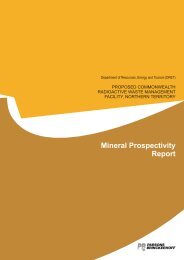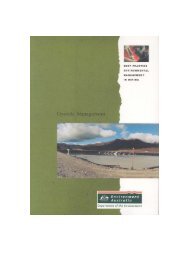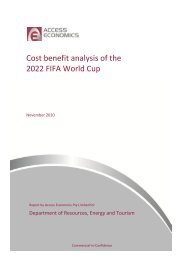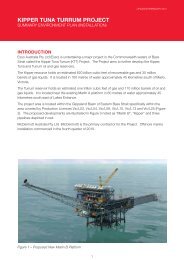A guide to leading practice sustainable development in mining
A guide to leading practice sustainable development in mining
A guide to leading practice sustainable development in mining
You also want an ePaper? Increase the reach of your titles
YUMPU automatically turns print PDFs into web optimized ePapers that Google loves.
Introduction<br />
In a perfect world, m<strong>in</strong>es only close when their m<strong>in</strong>eral resources are exhausted and<br />
a m<strong>in</strong>e closure plan is <strong>in</strong> place and progressively implemented. There is time available<br />
for plann<strong>in</strong>g, moni<strong>to</strong>r<strong>in</strong>g and trials, and funds are externally held <strong>to</strong> cover the costs<br />
of implement<strong>in</strong>g the closure plan. Pre-determ<strong>in</strong>ed outcomes can be achieved or<br />
progressed satisfac<strong>to</strong>rily and there should be ample opportunity <strong>to</strong> overcome any<br />
major issue that may create problems after closure. Stakeholders are prepared for<br />
the <strong>in</strong>tended closure date, employees can plan <strong>to</strong> f<strong>in</strong>d alternative employment, and<br />
the community has the opportunity <strong>to</strong> work with the m<strong>in</strong>e <strong>to</strong> ensure <strong>susta<strong>in</strong>able</strong><br />
benefits from the m<strong>in</strong><strong>in</strong>g activities.<br />
However, <strong>in</strong> the real world, m<strong>in</strong>es extract reserves not resources, and the grade and<br />
<strong>to</strong>nnage of reserves vary from day-<strong>to</strong>-day depend<strong>in</strong>g on the commodity price, ore<br />
quality or grade, further exploration results, geotechnical complications and other<br />
fac<strong>to</strong>rs which can result <strong>in</strong> m<strong>in</strong>e closure before the estimated reserve has been fully<br />
extracted. This situation can create significant problems for the m<strong>in</strong><strong>in</strong>g company, the<br />
community and the regula<strong>to</strong>r.<br />
There are many reasons why m<strong>in</strong>es may close prematurely. Research shows that<br />
almost 70 per cent of the m<strong>in</strong>es that have closed over the past 25 years <strong>in</strong> Australia<br />
have had unexpected and unplanned closures (Laurence, 2006). That is, they have<br />
closed for reasons other than exhaustion or depletion of reserves. These <strong>in</strong>clude:<br />
economic, such as low commodity prices or high costs that may<br />
lead a company <strong>in</strong><strong>to</strong> voluntary adm<strong>in</strong>istration or receivership.<br />
geological, such as an unanticipated decrease <strong>in</strong> grade or size of the ore body.<br />
technical, such as adverse geotechnical conditions<br />
or mechanical/equipment failure.<br />
regula<strong>to</strong>ry, due <strong>to</strong> safety or environmental breaches.<br />
policy changes, which occur from time-<strong>to</strong>-time,<br />
particularly when governments change.<br />
social or community pressures, particularly from non-government organisations.<br />
closure of downstream <strong>in</strong>dustry or markets.<br />
flood<strong>in</strong>g or <strong>in</strong>rush.<br />
Poorly closed and derelict (orphaned and abandoned) m<strong>in</strong>es provide a difficult legacy<br />
issue for governments, communities and m<strong>in</strong>erals companies and, ultimately, tarnish<br />
the m<strong>in</strong><strong>in</strong>g <strong>in</strong>dustry as a whole. Increas<strong>in</strong>gly, as access <strong>to</strong> resources becomes tied<br />
<strong>to</strong> <strong>in</strong>dustry and corporate reputation, effective closure processes and satisfac<strong>to</strong>ry<br />
m<strong>in</strong>e completion becomes critical <strong>to</strong> a company’s ability <strong>to</strong> develop new projects.<br />
Poor plann<strong>in</strong>g and <strong>in</strong>adequate f<strong>in</strong>anc<strong>in</strong>g commonly <strong>in</strong>crease the costs of closure and<br />
decrease overall profitability, hamper<strong>in</strong>g a company’s ability <strong>to</strong> develop new projects.<br />
Tak<strong>in</strong>g a more <strong>in</strong>tegrated approach <strong>to</strong> m<strong>in</strong>e closure plann<strong>in</strong>g, and do<strong>in</strong>g it earlier, can<br />
achieve effective m<strong>in</strong>e closure and completion, and ameliorate the negative effects<br />
of unexpected or unplanned closures.<br />
132 LEADING PRACTICE SUSTAINABLE DEVELOPMENT PROGRAM FOR THE MINING INDUSTRY


